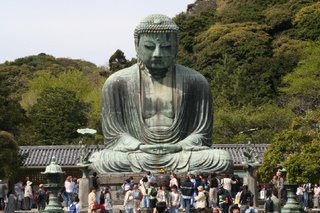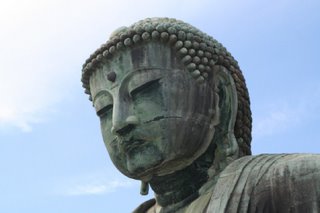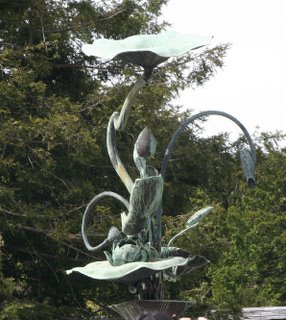On Saturday, we went with friends to the "Daibutsu", a colossal bronze statue of Amida, the pride and glory of Kamakura at the Kotoku-in temple, (which was swept away by a tidle wave).
It is situated in a sequestered grove.

You enter through a roofed gate, on either side of which the threatening figures of the Nio, or two Diva Kings, keep guard against demons and enemies of this sacred spot.

The bronze statue of Amida Buddha was cast in 1252 A.D. by the sculptors Ono-Goroemon and Tanji-Hisatomo at the request of Miss Inadano-Tsubone and Priest Joko.
The temple, covering this valuable statue, must have been a structure of great beauty and elaboration and suitable proportions; its mighty roof being supported by sixty-three massive pillars of which fifty of the circular stone bases still remain in evidence. In 1498, a tidal wave swept away the great Kotoku-in temple of the Buddha.

The mighty figure has reigned in solitary majesty over the little valley for more than 700 years; where it has successfully resisted the havoc of storms and floods, and through the succeeding centuries has been the object of worship and admiration to countless streams of pilgrims and visitors from all corners of the world.

The statue is 13.35 meters tall/50 feet, and weighs 121 tons.
The face is over 8 feet in lenght. Upon the head are 656 curls, a traditional characteristic of Amida.
The atmosphere around the Daibutsu accentuates its austere majesty and utter aloofness from the unrest and turbulence of this human earth-life. He is a symbol of repose and absolute detachment from the world.

Before the deity is an incense burner and two tall bronze lotus flowers, fifteen feet in height.
It is situated in a sequestered grove.

You enter through a roofed gate, on either side of which the threatening figures of the Nio, or two Diva Kings, keep guard against demons and enemies of this sacred spot.

The bronze statue of Amida Buddha was cast in 1252 A.D. by the sculptors Ono-Goroemon and Tanji-Hisatomo at the request of Miss Inadano-Tsubone and Priest Joko.
The temple, covering this valuable statue, must have been a structure of great beauty and elaboration and suitable proportions; its mighty roof being supported by sixty-three massive pillars of which fifty of the circular stone bases still remain in evidence. In 1498, a tidal wave swept away the great Kotoku-in temple of the Buddha.

The mighty figure has reigned in solitary majesty over the little valley for more than 700 years; where it has successfully resisted the havoc of storms and floods, and through the succeeding centuries has been the object of worship and admiration to countless streams of pilgrims and visitors from all corners of the world.

The statue is 13.35 meters tall/50 feet, and weighs 121 tons.
The face is over 8 feet in lenght. Upon the head are 656 curls, a traditional characteristic of Amida.
The atmosphere around the Daibutsu accentuates its austere majesty and utter aloofness from the unrest and turbulence of this human earth-life. He is a symbol of repose and absolute detachment from the world.

Before the deity is an incense burner and two tall bronze lotus flowers, fifteen feet in height.


0 Comments:
Post a Comment
<< Home